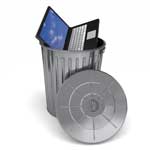
I am old enough to remember a time when appliances and electronics were expensive, big and lasted a long time. Due to their cost, you fixed things that broke and they did not quickly become obsolete. Every neighborhood had a TV Repair Service or a Handy-man who could fix TV’s, radio’s, phonographs, appliances, vacuum cleaners, etc. A recent AARP article (see, I am old) updated the old 50% rule. In essence, if the repair cost less that 50% of the replacement cost of an item, then repair it.
Sadly, this old rule is at odds with our current digital age and Moore’s Law. Moore’s Law is named after Intel co-founder Gordon E. Moore, who described the trend in a 1965 paper. He noted that the number of components in integrated circuits had doubled every two years from the invention of the integrated circuit in 1958 until 1965 and predicted that the trend would continue.
I bought my first “personal” computer, a Commodore Vic-20 in 1980. I still have it sitting in our basement. I bought my second PC in 1985, a Tandy 1000. Since then, the number of computers I have bought are t00 numerous to mention. It seems, like Moore predicted, that I would be replacing a computer every few years. Sometimes it is because something went wrong with it, but often, it is just because I need (or want) a newer, more powerful and faster computer. It is even worse with cell phones. I had drawers filed with close to twenty old cell phones. Often they worked fine, but I received a newer phone with better features by re-signing another 2-year contract with my wireless provider.
As mentioned in the My Life Scoop Blog, the United Nations Environmental Program estimates that each year, 20-50 million tons of e-waste is dumped into landfills around the world, ranging from old phones, TVs, microwaves, computers and more – but most of the time it’s not because these gadgets are defunct; they’re being dumped in favor of new releases. They go on to say that most people fail to properly dispose of their unwanted electronics, carelessly trashing them without regard to the hazardous materials they contain, including PCBs, lead and mercury. Many of these chemicals are known to cause cancer, respiratory illness, and reproductive problems, and damage the earth by seeping into the soil and ground water.
My wife finally had enough of this e-waste build up and in no uncertain terms told me to find a home for all these gadgets. Fortunately, we live in Farmington Hills, MI and our local recycling authority, RRRASOC accepts e-waste at its Southfield location. They also accept e-waste at the various Household Hazardous Waste Collection Events that they hold throughout the year.
RRRASOC points out that e-waste:
“…is the fastest growing portion of the municipal waste stream. As those products reach the end of their useful life, it is important to remember that many of these products are reusable, recyclable, or pose a concern if not handled properly.”
It is important to use an e-waste recycler that you trust. There are some e-waste recyclers out there that say they recycle the e-waste in an environmentally sustainable manner, but in reality do not. A recent Waste & Recycling News article stated that for the first time criminal charges have been filed against electronic waste recyclers accused of duping customers and sending e-waste abroad to developing countries.
According to the article:
“…the indictment says the company developed a scheme to falsely represent that it would dispose of all e-waste in an environmentally friendly or green manner. The company also said it would recycle the items in the U.S., not overseas… Executive Recycling was the subject of a “60 Minutes” report in 2008 which tracked containers from its facility to Hong Kong.”
Executives for the company could spend up to 20 years in prison, if convicted on the most serious charges. An even better way to get rid of functional e-waste is to donate them. Most schools, charities and places of worship run on very tight budgets. What appears to you as an obsolete computer or printer, may be a step up for them or one of their clients. At this years Plymouth Green Street Fair, unwanted e-waste was donated to raise money for Beaumonts’ Chidren’s Hospital. Another exhibitor collected used cell phones to be turned into prepaid phone cards for US Soldiers in Iraq and Afghanistan to call their families.
Despite these efforts, the e-waste at both my home and office continues to grow. If you have a good suggestion for a way to recycle or donate e-waste, please let us know in the comments.
Related Links:







